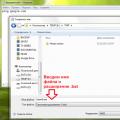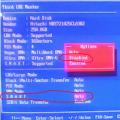I think everyone knows the feeling of hopelessness when time is running out, deadlines are running out, and the computer, in no hurry, is thinking about its next move. We are nervous, desperately trying to identify a very harmful virus, but everything is in vain. What to do in such a situation?
Of course, scanning for viruses and defragmenting the disk are necessary procedures, but there are more compelling reasons for low system productivity. And that reason is background applications. By getting rid of them, you can forget about the endlessly “thinking” computer and pop-up windows for a long time.
What are background applications
A very common phenomenon is an incredible accumulation of all kinds of shortcuts on the desktop, the next destination is the system configuration in the Startup tab of the Start menu. There are even more icons here, and each one represents either an active program or an application running in the background.
Background programs in Windows 7 start automatically when the system starts, and sometimes we don’t even suspect that we have up to two dozen programs running in the background that we’ve never even heard of. As a rule, these are useful utilities, antiviruses, all kinds of download managers, etc., that get into the system as a free load in addition to the programs that we install ourselves or download from the network. Poor system performance is due to the fact that background files consume a lot of memory. The problem can be solved quite simply - disable unnecessary applications and services.
Ways to identify and remove background programs
The methods described above are simple and accessible to everyone; with their help you will free up the RAM of your machine and significantly increase its performance.
Articles and Lifehacks
Every user has heard about what background mode is on a phone at least once in their life.
It is worth rightly noting that current cellular devices have become an integral part of the lives of ordinary people, since they allow not only to always stay in touch, but also to take photographs, use the device as an e-reader, navigator and game console.
What is background mode for?
- However, all these manipulations lead to the fact that the phone or smartphone simply loses its charge. This problem is especially often faced by those who like to surf sites on the Internet.
- To minimize the occurrence of this problem, it is worth considering in detail the issue of using the background mode. If you disable the ability to receive and transmit data through this mode on your phone.
- Background functioning on a modern cellular device is usually understood as a special process.
- Even during that period of rest, when the Internet browser on the phone is not turned on and various programs are not running, the device remains capable of not only receiving, but also transmitting entire packets of information.
Features of the mode

- It is worth remembering that any program, when downloaded to a cellular device, implies the possibility of adjustment. That is, the settings may not allow access to the Internet without the user’s permission.
- Thus, it should be noted that it is possible to optimize the user’s expenditure of mobile device resources.
- After all, when you absolutely need to stay connected, but there is no way to connect to a power source, the best option is to simply block access to Internet browsers in the background system itself.
- To do this, you just need to disable the option responsible for information exchange. As a rule, you just need to enter the menu and find the settings category.
- To be fair, it is worth noting that, as a rule, the user forgets about the background mode on the phone, as a result of which the battery drains as quickly as possible.
- If you put a shortcut on the device screen indicating the settings, then the habit of turning it off will develop by itself.
- This approach to using a telephone will allow ordinary people not to worry about the sudden discharge of the battery and the inability to make a call.
On your device, you know how amazing the new operating system is. With innovations like multitasking and picture-in-picture, as well as improved background app management and updated settings, Android Oreo is the best version of Android OS we've had so far. However, nothing is perfect and Android Oreo has its problems too. For example, there is permanent notice from the Android system both on the lock screen and on the notification panel. It shows the number of applications running in the background.
Although the developers' intention is to alert users about possible harmful apps running in the background, the constant presence of this Android system notification is annoying. If you are also not happy with it and would like to remove this information from the screens, we are ready to offer you a couple of ways to solve the problem.
Let's be honest: The solution is not absolute, since although users will be able to get rid of the notification icon on the lock screen, it will still be displayed when the notification panel is displayed. And yet, even such a decision is better than no decision.
How to remove the “The application is running in the background” notification?
That's all you need to do to remove the "Apps running in the background" notification for Android. However, note that it will still be present when the notification panel is displayed.
Remove a notification using the Hide “running in the background” Notification program:
The developer iboalali has released an application called Hide "running in the background" Notification, which eliminates the need for users to contemplate notifications about programs running in the background. For those who want to make sure they don't install anything malicious on their phone, the source code is available. The application itself is free, but there is a voluntary donation option for users who wish to thank the developer. You can download the application fromBackgroundapplications/processes are called, which work in the background (hidden from the user) mode.
Some of them are not used by the user, nevertheless consuming system resources, and accordingly reducing the efficiency of equipment use; some simply litter the taskbar, desktop and list of installed programs.
Some of these programs are various services that are started by the operating system. Due to its versatility, the operating system runs a large number of applications, some of which you will never specifically need. In addition, some of the background applications in turn launch their own background applications, such as MS Office. Removing applications you don't use will help speed up system startup and free up computing power.
ctrl+alt+del)
2.3 Via Msconfig (SCU)
2.4 Through the Windows registry (regedit)
3. Background services, pages and other processes
4. Bring your device to the service center for repairs
1. Basic types of background applications
You can view running applications in the Windows taskbar. As a rule, these are various download managers, antiviruses, “daemons”, “wizards”, and other useful and not so useful utilities. Those that are “not so good” end up on your machine in different ways: as an “add-on” to files downloaded from the Internet, when installing various programs using the “default” method, etc. Taking a few minutes to disable unnecessary applications and services can improve the performance of your hardware. Background services compete with user tasks for memory, increasing the number of calls to the page file, thereby reducing the efficiency of the entire system.
2. Ways to detect and remove background processes
To view the list of applications that launch automatically, press .
“Honest” programs are reflected here; you can remove them from startup by right-clicking – “delete”, while the program itself is NOT deleted, it just stops loading automatically when Windows starts . Other background programs are “hiding”, and we need to be able to find them.
Pay attention to your computer's taskbar (usually the lower right corner). There are shortcuts to programs that are launched by default
In this case, we see the uTorrent download manager, 2GIS update agent, Skype, DAEMON Tools lite disk emulator and others.

Fig.2. List of programs in the taskbar
The programs that we see in the taskbar can be unloaded by pressing the right key:



Fig.3. Shutting down (unloading) programs
Comment: when using the Exit button, Exit The unloaded process starts again when windows is restarted. If you need to turn it off permanently, use msconfig, regedir.
2.2 Using the task manager ( ctrl+alt+del)
By launching the Windows Task Manager (by pressing Ctrl+Alt+Delete), you can look at the list of background services. Windows distinguishes between user applications and system services. On the “Applications” tab you can see running programs, on the “Processes” tab there is a list of system services and application components.

Fig.4. Task Manager, Applications tab
The End task button can be used to kill a program or process
In the Processes list you can see the same programs that we saw on the taskbar and more. For example, the explorer.exe component is the familiar Windows Explorer, and iexplore.exe is the Internet Explorer browser.
Fig.5. Task Manager, Processes tab
Modules you don't need can be removed by clicking the " End the process" You can safely delete processes:
TweakUI (tweakui.cpi) - operating system configuration utility;
MS WebCheck Monitor (loadwc.exe) – configures Microsoft Explorer on first launch;
ShedulingAgent (mstask.exe) - task scheduler (if not used);
Microsoft Office Wrapper (osa.exe) - launch accelerator for MS Office programs;
File Open (findfast.exe) - speeds up searching in office documents
Internat.exe - keyboard layout indicator;
System Tray (systray.exe) is a program that creates icons in the system area of the Taskbar.
Comment: The unloaded process starts again when Windows is restarted. If you need to turn it off permanently, use msconfig or regedir.
2.3 Via MSCONFIG (SCU)
In Windows, there is a special utility System Configuration Utility (SCU). It can be launched by specifying MSCONFIG in the program launch line Start ->Run. It is simple and easy to use and allows you to manage running applications. The utility contains several tabs that allow users to change OS startup parameters.
The information we need is located on the Startup tab and contains a list of applications that start when Windows boots. On this tab you can disable them as needed.
Programs, the list of which we see in SCU, are deleted there. SCU allows you to experimentally significantly increase system performance and remove all unnecessary things. Once you find a program you don't need, you can remove it from the download list in the SCU panel.

Fig.6. SCU Utility (MSCONFIG)
2.4 Through the Windows registry (regedit)
Programs that are registered in the system registry when loaded can be removed using the program REGEDIT(keyboard shortcut win + r, team regedit.exe). As always, before making major changes to the system, we do a backup and, as always, we do this only when we are completely confident in our abilities. Most often, such programs are located in the branch HKEY_LOCAL_MACHINE\SOFTWARE\Microsoft\Windows\CurrentVersion\Run. Removal from the program is carried out by deleting the corresponding registry line.
Unfortunately, not all programs can be removed using the methods listed above. Microsoft will not allow you to delete, for example, Windows Messenger. This rather useless program is installed by default, and is not visible in the Add or Remove Programs dialog of the Control Panel. If you want to remove one of these programs, you will have to edit the file SYSOC.INF, which is located in C:\WINDOWS\INF default. To do this, first find the title , which contains options for loading various Windows components. Those that contain the parameter "hide"- the Add/Remove Programs panel is not visible, for example msmsgs = msgrocm . dll , OcEntry , msmsgs . inf , hide ,7 in the case of Messenger, after removing this parameter, the component becomes visible in the Add or Remove Programs panel.
3. Background services, pages and other processes
In addition to background applications and processes, there are also background pages, services, etc., but we will talk about them next time.
The phrase “background mode” appears quite often, including on resources one way or another related to modern smartphones. But not everyone knows what this phrase means. Well, we will answer this question.
Background mode is a mode where applications and some processes run without user interaction. For example, it could be some kind of messenger. Yes, you don’t see the application working, but only until a message arrives from your friend. If everything is clear with this example, then the situation is much more interesting with some built-in applications that are completely unnecessary for the user, but at the same time waste the resources of the touch device. Unfortunately, such applications are not removed; they can only be stopped or disabled.
Applications in the background can independently connect to the server when the Internet is connected - mobile or Wi-Fi. So, for example, you can receive a notification about a firmware update for your smartphone.
The disadvantage of individual applications that run in the background is increased energy consumption, as a result of which the device’s battery drains faster. But, fortunately, this does not happen very often.
You need to understand that some applications cannot work without a background mode, for example, these are the same messengers or antiviruses. And that's okay.
You can almost always turn off an app running in the background. Open settings.

Select the "Applications" section.

Find the application you need in the list.

Stop it or turn it off as needed.

Confirm the action.

In the future, the application must be launched manually.





